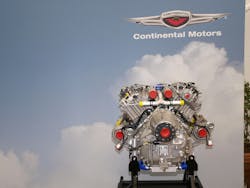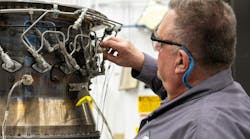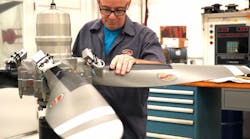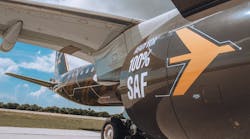In the last two decades we haven’t seen many new certified engines in the gasoline engines world - in a diesel cycle, engine field it was quite different. The available diesel engines in aviation were not too many, especially before a decade ago, but their number has grown steadily and almost radically in the last year. Continental Motors has become a market leader in diesel engine field and is now further reinforcing its position with the addition of the all-new 300-hp, CD-300 engine to its already wide diesel engine portfolio.
Continental was for decades the major player in a gasoline aviation engine field, and this part of the story is pretty well known. Now it has become the engine manufacturer with the highest number of diesel-cycle engines in its portfolio, especially after the introduction of the certified 300-hp, six "V" layout, CD-300 engine series. This engine that recently obtained EASA certification in Europe will shortly become FAA certified in the United States. The CD-300 seems to be a highly appealing engine to the GA airframe manufacturers. Once Paul Poberezny, past EAA president, said to me: "First there has to be an engine and then the designer can build or adapt the aircraft around it" - wise words from the icon of the aviation world.
The article idea
I started thinking of writing an article on diesel engines almost a year ago. The idea was to write a general diesel-aviation market overview but in a certain moment - especially during the visit to the Continental Motors manufacturing facility in Germany - I realized that Continental Motors wass quite close to certifying a new 300-hp engine that was running on different test benches.
During that visit, actually even before it, to the Continental Motors Germany (the plant and certifications operate under the name Technify Motors GmbH) facility, I realized that many people are confused with the different names, they don't know how these companies are related to each other, and - last but not least - that many simply have not (yet) understood that Continental Motors re-branded their diesel engine range three years ago.
Taking all that in account I intend to explain the relationship between the Continental Motors Group and Technify Motors and to present the Continental diesel engine range. Additionally I intend to write about a week-long Continental Diesel Maintenance Seminar I attended at a later date.
Continental Motors Group in Germany
Continental Motors Germany is located in St. Egidien, province of Saxony, on the East German border. Today the plant is a leading manufacturer of certified diesel (jet-fuel) piston aircraft engines for general aviation, and is part of the Continental Motors Group (CMG) since July 2013. Continental Diesel has a global network of over 350 authorized service centers for worldwide customer support.
The German plant also produces engine components and engine applications for defense and automotive industry. Continental Motors Germany manufactures compression ignition piston engines for unmanned aerial vehicles (UAV) and general aviation aircraft. The company possesses aviation certifications as development, production, maintenance, and training organization (JAR 21-J, JAR 21-G, Part-145, and PART-147).
Continental’s German-produced CD-100 and new CD-300 engine families are lightweight, heavy fuel engines in the power-classes from 135 to 350 hp. The engines have proven to be highly suitable power plants for UAV and be adapted to marine and other non-aircraft applications. Continental Motors Germany also offers tailor-made development services and the manufacturing of engine components for aircraft, automotive, and defense industries. Most engine parts are in-house manufactured with most advanced machinery and all processes and products are subject to strict quality assurance. A data recording and specification system facilitates seamless electronic traceability of all manufactured products. Internally, the best possible measurement techniques and quality management systems (e.g. Six Sigma) are employed.
Altogether, 5,250 plus Continental Diesel engines delivered to date have logged more than 5.25 million flight hours.
The Roots of Continental Diesel Engines
Let’s take a look on Continental Motors Germany’s history which has seen all tides of economy. The roots can be found in a car workshop company named after its founder Frank Thielert who started the business in 1989 in Hamburg, Germany. Thielert’s main activities were initially in a car field and classic car motorsports. As Thielert Motoren GmbH in mid-'90s it expanded activities toward professional motorsports and automotive parts manufacturing owning engine development and manufacturing departments. The company started with the development of diesel aviation engines using and modifying modern, German automotive diesel engines and built a plant in St. Egidien. In 2000 the first diesel powered flight was performed in a Valentin Taifun aircraft. At that time the company was re-organized in two units: The heritage Thielert Motoren GmbH in Hamburg focused on development and automotive field, and the newly founded Thielert Aircraft Engines GmbH in St. Egidien, Saxony, plant dedicated to production of diesel engines. Both companies were owned by the financial holding named Thielert Aktiengesellschaft (a non-stock corporation).
In year 2002 the company started marketing diesel engines named “Centurion.” To back the huge development cost and expand with a third plant in Altenburg, Thuringa the Aktiengesellschaft made an IPO (initial public offering of shares) in 2005. However, the financial situation became stretched during the economic crisis which peaked in 2008. The company was forced to file for insolvency. In the following five years the company was restructured and made lean, continuing the production and improvement of the diesel engines. In July 2013 the purchase of the bankrupt assets of Thielert Aircraft Engines GmbH was announced by the Chinese-based AVIC International Holding Corporation, the same company that bought Continental Motors, Inc. in 2011 from Teledyne and now integrates the general aviation business under the wings of the Continental Motors Group (CMG).
Engine range re-branding
Continental re-branded its diesel engine range in 2014. The diesel engines formerly known and sold under the brand name Centurion were re-named to Continental Diesel, abbreviated as CD.
• CD-100 series: The former Centurion 2.0/2.0s engines have become the CD-100 series engines with 135 and 155 hp, today’s designation CD-135/155
• CD-200 series: The former TD-300 engine was re-named to CD-230 and CD-245, four-cylinder, opposite, air-oil cooled, turbocharged engine, with 230-245 hp. During AirVenture 2017, the CD-262 was introduced.
• CD-300 series: The brand new V-6 diesel, 3.0-liter, engine with 300-hp output gained in 2017 the European certification.
• Centurion 4.0: The "V-Eight” style liquid-cooled geared 310-hp Centurion 4.0, was certified by Thielert but never entered service. European STCs exist for installations of the Centurion 4.0 in the Cirrus SR22 and the Cessna 206. This engine could be neglected because it was abandoned - here listed only as general information.
CMG Diesel engine range
• CD-100 family, CD-135/155
CD-135/155 is a CMG jet-fuel piston engine for general aviation with a takeoff power of 135 HP and 155 HP. The CD-135/155 is a turbo charged, 4-cylinder in-line, liquid cooled and geared engine which is EASA certified since August 2006 and FAA certified since October 2006. The predecessor Centurion 1.7 liter is certified by the European Aviation Authorities since May 2002 and the FAA certified since October 2003. The weight of all Centurion engines 1.7 and CD-135 is identical so that each 1.7 engine can be replaced by a CD-135. The CD-155 engine is basically the same engine and same weight 294 lbs (134kg) but 155 HP output.
• CD-200 series
The 230-hp engine was purchased in 2009. The traditional looking engine is air-cooled, direct drive, flat, four cylinder fitted with an engine-driven mechanical piston fuel injection pump. That engine was certified in 2012 and Continental pursued both OEM and STC conversion markets. This engine was installed in a Cessna 182 but had little interest. This is likely to change now as the more powerful, modernized version called CD-265 with 262 hp was debuted at AirVenture 2017 in Oshkosh. The rotorcraft version is called CDR-282 and develops 282 hp. Although being more powerful and more refined, the CD-262 is approximately 8 pounds lighter.
• CD-300 series
The CD-300 is the newest and most powerful engine in the CMG portfolio. The CD-300 is a 3.0-liter, "V-6” style four-stroke, liquid-cooled, diesel cycle piston engine with high pressure common rail direct fuel injection, four valves per cylinder and is twin turbocharged. There is a Propeller Speed Reduction Unit (gearbox) with 1:1.66 reduction ratio and electronic/FADEC engine control unit. The engine weighs 547 pounds (265 kg) dry, and is compact thanks to the "V" layout. Power output is stated to be 300 hp for five minutes and 272 hp maximum continuous power at 3,880 rpm (2,340 prop rpm). This engine was recently certified CS-E by the EASA in Europe (June 20, 2017) and FAA (FAR-33) validation is expected shortly.
The engine was in-flight tested on a modified Cirrus SR-22, and the first customer is Reiner Stemme Q01 surveillance aircraft. There are many potential aircraft in the market which are suitable for the firewall-forward retrofit kit like: Cessna 206, Beechcraft Bonanza, and Cirrus SR. By the way, the testbed SR serial cowling was only slightly modified to accommodate this power plant.
Common characteristics of CD-100 and 300 engines
All CD-100 and CD-300 engines use a full electronic engine control and an integrated propeller management system (FADEC), a true single lever control, and a reduction gearbox. They are liquid cooled, turbocharged (the CD-300 twin turbocharged), and fitted with the inter-cooler(s) for the induction air. Those engines are based on German automotive engines but heavily modified and adapted for aviation use.
The CD-100 engines are FAA, EASA, and CAAC certified and can be used with Jet-A, Jet A-1, diesel, JP-8 and other kerosene based fuels. Compared to conventional aviation gasoline power plants, and according to CMG, the CD engines reduce the specific fuel consumption by an average of 40 percent. Certified installations are available for the most common general aviation training aircraft like Cessna 172, Piper PA28, Robin DR400, and Diamond DA40, as well as Diamond DA42. The engines are in serial production for general aviation and defense applications.
The FADEC system used in the CD-100 and CD-300 series is a fully redundant 32-bit motor management system for the Continental Diesels. The hard- and the software of the FADEC was completely developed in house respecting the international aviation standards (EASA, FAA). The certified FADEC passed difficult test criteria of the EMV. The ECU regulates the high-pressure valves, the common rail pressure, the turbo charger, and the constant speed propeller's pitch. Furthermore the FADEC contains more special functions like the electronic event logging which saves diagnostic data, sensor monitoring, diagnostic interface, the integrated run-up check, or the continuous surveillance of more than 30 internal and external engine parameters.
Conclusion
Over time the Continental Diesel products have grown matur,e and today can be seen as an established player and as the leader in diesel engine market. The TBR (Time Before Replacement) has meanwhile dramatically grown for the CD-100 series to 2,100 hours for the engine, with only a gearbox inspection needed at 1,200 hours. The service intervals have radically increased after the introduction of the clutch design change in 2010 with the introduction of second generation gearbox.
Continental Diesels CD-100 range has overcome their teething problems with the switch from 1.7- to 2.0-liter displacement in 2006. According to what I have seen and heard in the factory, the CD-300 start-up should benefit from the lessons learned. This engine, as with other Continental Diesels, is for some fleet operators and owners increasingly interesting. Those diesels are not only viable alternatives to existing gasoline engines, but are sometimes the only practicable choice as in many remote areas of the world where avgas is not available at all and jet fuel is widely available at a lower cost. In the diesel engine field Continental Motors has become a diesel giant - a manufacturer with the widest portfolio on the market.
For more information please visit www.continentalmotors.aero.





